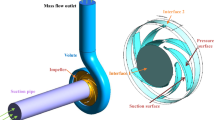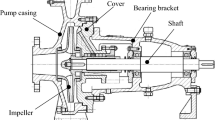Abstract
Cavitation may not only cause head and efficiency breakdown of hydraulic machines but also generate other unfavorable phenomena such as noise and vibration. Therefore, the accurate prediction of cavitation development is important for various pump applications. In this paper, two numerical models, namely, models A and B, are applied to simulate the turbulent cavitating flows inside a centrifugal pump to investigate the effect of calculation domain on the prediction accuracy of cavitation performance for hydraulic machines. Model A has a calculation domain with volute casing, whereas model B has a single blade-to-blade flow passage without volute casing. Steady simulations of cavitating flow in the pump have been conducted based on the shear stress transport k-ω turbulence model and the homogeneous cavitation model. Both models A and B predicted that the pump performance decreases with decreasing cavitation number. Experimental results show that model B can predict better the critical cavitation number at the best efficiency point compared with model A, which is the full flow passage model. Internal flow investigations indicate that an asymmetrical feature of cavitating flow exists when the calculation domain with volute casing is applied. The asymmetrical cavitation development in different blade-to-blade flow passages for model A results in an over-estimation of the decrease in pump performance because of the interaction between the impeller blade and the tongue of the volute casing. A simple calculation domain without volute casing is preferred for steady cavitation prediction in pumps rather than the full flow passage with volute casing because the former has better convergence, less resource requirements, and lower time consumption.
Similar content being viewed by others
References
X. W. Luo, B. Ji and H. Y. Xu, Design and optimization of fluid machinery, Tsinghua University Press, Beijing, China (2012).
X. W. Luo, B. Ji, X. X. Peng, H. Y. Xu and M. Nishi, Numerical simulation of cavity shedding from a three-dimensional twisted hydrofoil and induced pressure fluctuation by Large-Eddy Simulation, Trans. ASME J. Fluids Eng., 134(4) (2012) 041202 1–10.
B. Ji, X. W. Luo, Y. L. Wu, X. X. Peng and H. Y. Xu, Partially-Averaged Navier-Stokes method with modified k-ɛ model for cavitating flow around a marine propeller in a non-uniform wake. International Journal of Heat and Mass Transfer, 55(23–24) (2012) 6582–6588.
W. Wei, X. W. Luo, B. Ji, B. T. Zhuang and H. Y. Xu, Cavitating flow investigation inside centrifugal impellers for a condensate pump, IOP Conf. Ser.: Earth Environ. Sci., 15 (2012) 032061 1–8.
B. Ji, X. W. Luo, X. X. Peng, Y. L. Wu and H. Y. Xu, Numerical analysis of cavitation evolution and excited pressure fluctuation around a propeller in non-uniform wake. International Journal of Multiphase Flow, 43 (2012) 13–21.
H. Ding, F. C. Visser and Y. Jiang, Demonstration and validation of a 3D CFD simulation tool predicting pump performance and cavitation for industrial applications, Trans. ASME J. Fluids Eng., 133(1) (2011) 011101 1–6.
X. W. Luo, Y. Zhang, J. Q. Peng, H. Y. Xu and W. P. Yu, Impeller inlet geometry effect on performance improvement for centrifugal pumps, Journal of Mechanical Science and Technology, 22 (2008) 1971–1976.
B. T. Zhuang, X. W. Luo, W. P. Yu, L. Zhu, Y. N. Li and H. Y. Xu, Design optimization for suction structure of multistage vertical barrel pump, Journal of Drainage and Irrigation Machinery Engineering, 28(1) (2010) 1–6.
X. W. Luo, S. H. Liu, Y. Zhang and H. Y. Xu, Cavitation in semi-open centrifugal impellers for a miniature pump. Frontier of Energy and Power Engineering in China, 2(1) (2008) 31–35.
Y. Zhang, X. W. Luo, Y. C. Yi, B. T. Zhuang and H. Y. Xu, Investigation on the flow field upstream of a centrifugal pump impeller, Journal of Engineering Thermophysics, 32(S1) (2011) 33–36.
F. R. Menter, Two-equation eddy-viscosity turbulence models for engineering applications, AIAA Journal, 32(8) (1994) 1598–1605.
A. K. Singhal, M. M. Athavale, H. Y. Li and Y. Jiang, Mathematical basis and validation of the full cavitation model, Trans. ASME J. Fluids Eng., 124(3) (2002) 617–624.
X. Luo, A study on impeller inlet geometry suitable for a mini pump, Doctoral dissertation of Kyushu Institute of Technology, Kitakyushu, Japan (2004).
Author information
Authors and Affiliations
Corresponding author
Additional information
Xianwu Luo received his B.S. and M.S. degrees from Tsinghua University, Beijing, China in 1991 and 1997 and his Ph.D. in Mechanical Engineering from Kyushu Institute of Technology, Japan, in 2004. He is currently an associate professor at Department of Thermal Engineering, Tsinghua University, China.
Rights and permissions
About this article
Cite this article
Luo, X., Wei, W., Ji, B. et al. Comparison of cavitation prediction for a centrifugal pump with or without volute casing. J Mech Sci Technol 27, 1643–1648 (2013). https://doi.org/10.1007/s12206-013-0411-5
Received:
Revised:
Accepted:
Published:
Issue Date:
DOI: https://doi.org/10.1007/s12206-013-0411-5




